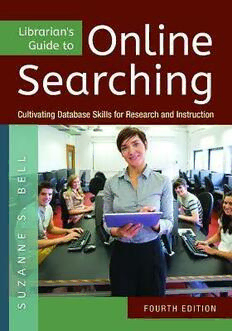
Librarian’s Guide to Online Searching: Cultivating Database Skills for Research and Instruction PDF
Preview Librarian’s Guide to Online Searching: Cultivating Database Skills for Research and Instruction
2 3 Copyright © 2015 by Suzanne S. Bell All rights reserved. No part of this publication may be reproduced, stored in a retrieval system, or transmitted, in any form or by any means, electronic, mechanical, photocopying, recording, or otherwise, except for the inclusion of brief quotations in a review, without prior permission in writing from the publisher. Library of Congress Cataloging-in-Publication Data Bell, Suzanne S. Librarian’s guide to online searching : cultivating database skills for research and instruction / Suzanne S. Bell. — Fourth edition. pages cm Includes bibliographical references and indexes. ISBN 978-1-61069-998-3 (pbk : alk. paper) — ISBN 978-1-61069-999-0 (ebook) 1. Database searching. 2. Electronic information resource searching. I. Title. ZA4460.B45 2015 025.04—dc23 2014038457 ISBN: 978-1-61069-998-3 EISBN: 978-1-61069-999-0 19 18 17 16 15 1 2 3 4 5 This book is also available on the World Wide Web as an eBook. Visit www.abc-clio.com for details. Libraries Unlimited An Imprint of ABC-CLIO, LLC ABC-CLIO, LLC 130 Cremona Drive, P.O. Box 1911 Santa Barbara, California 93116-1911 This book is printed on acid-free paper Manufactured in the United States of America 4 To my grandfather, Augustus Hunt Shearer, librarian and teacher, and my father, Vern Coventry Bell, inventor and engineer. You may not have understood this book, but you would have appreciated it. Thank you both for the gifts that made it possible. 5 Contents Preface Acknowledgments 1: INTRODUCTION TO LIBRARY DATABASES What Is a Database? Is Google a Database? Historical Background Indexing and Abstracting Services From Printed Volumes to Databases The Library Database Industry Today Discovery Services 2: DATABASE STRUCTURE FOR EVERYONE: RECORDS, FIELDS, AND INDEXES Database Building Blocks Fields, Records, and Tables Quick Recap Beyond Fields and Records Field Indexes Quick Recap Examples of Indexes in Common Databases Exercises and Points to Consider 3: THE SEARCHER’S TOOLKIT: PART 1 The First Basic Tools Basic Tool No. 1: Boolean Logic Quick Recap Basic Tool No. 2: Controlled Vocabulary Basic Tool No. 3: Field Searching Terms in the Searching Lexicon Quick Recap Applying the Tools 6 MasterFILE Premier: Notes and Search Examples Exercises and Points to Consider 4: THE SEARCHER’S TOOLKIT: PART 2 Completing the Toolkit: Basic Tools 4–7 Basic Tool No. 4: Proximity Searching Basic Tool No. 5: Truncation Quick Recap Basic Tool No. 6: Limits to Constrain Your Search Basic Tool No. 7: “Learning from Your Results,” A Useful Search Strategy Quick Recap Your Mental Toolkit Summary and Advice Exercises and Points to Consider Suggested Reading 5: SOCIAL SCIENCE DATABASES Introduction to Subject Databases Library Literature & Information Science Background and Coverage Notes and Search Examples Quick Recap ERIC on the Web Background and Coverage Notes and Search Examples Quick Recap PsycINFO from Ovid Background and Coverage Notes and Search Examples Working with Results Additional Feature: The PsycINFO Thesaurus Quick Recap Additional Resources for Social Science Exercises and Points to Consider Beyond the Textbook Exercises—see Student Resources site 7 6: DATABASES FOR SCIENCE AND MEDICINE PubMed and MEDLINE PubMed: More than MEDLINE Introduction to the PubMed Interface Notes and Search Examples Output in PubMed Quick Recap Additional Resources for Medicine The Web of Science and the Citation Indexes Citations and the Academic Researcher An Index Focused on Citations Additional Differences in Fields Available Web of Science Coverage Searching the Web of Science: Main Search Interface Cited Reference Searching Email, Print, Save, or Export Results Advanced Features: Advanced Search and Analyze Quick Recap Additional Resources for Science Exercises and Points to Consider Beyond the Textbook Exercises—see Student Resources site 7: BIBLIOGRAPHIC DATABASES WorldCat: The “OPAC of OPACs” Background and Coverage A Tool for Many Parts of the Library Notes and Search Examples Quick Recap WorldCat.org Brief Background Notes and Search Examples Quick Recap Revisiting Your Local OPAC Exercises and Points to Consider Beyond the Textbook Exercises—see Student Resources site 8 8: HUMANITIES DATABASES America: History and Life Background and Coverage Notes and Search Examples The Folder: Outputting Results Special Feature: CLIO Notes Quick Recap MLA International Bibliography Background and Coverage Notes and Search Examples The Marked List and Output Additional Feature: Directory of Periodicals Quick Recap Additional Resources for Humanities Exercises and Points to Consider Beyond the Textbook Exercises—see Student Resources site 9: NUMERICAL DATABASES Finding Numbers Concepts about Numbers Quick Recap A Comment about Searching for Numbers Statistical Insight from ProQuest Background and Coverage Notes and Search Examples Outputting Records Quick Recap American FactFinder Background and Coverage Notes and Search Examples Quick Recap Bureau of Labor Statistics Pay & Benefits at the Bureau of Labor Statistics Occupation Information at the Bureau of Labor Statistics Quick Recap 9 Additional Resources for Statistics Numbers and the Reference Interview Exercises and Points to Consider Beyond the Textbook Exercises—see Student Resources site Suggested Readings 10: FOCUS ON PEOPLE Part 1: Information Seeking Behavior Some Theoretical Background on Information Seeking Applied Research on Information Seeking Behavior Information Seeking in the Internet Era Quick Recap Part 2: The Reference Interview Essential Components of the Reference Interview Interpersonal Communication Skills in the Reference Interview Beyond the Face-to-Face Reference Interview Why Is the Reference Interview So Important? Quick Recap Exercises and Points to Consider Suggested Readings 11: CHOOSING THE RIGHT RESOURCE FOR THE QUESTION Start with the Reference Interview Questions for Databases Why and When to Try a Database Quick Recap Choosing a Database Google Scholar Quick Recap Questions for the Web Personal Uses of the Web Professional Uses of the Web Quick Recap Exercises and Points to Consider Suggested Readings 10
